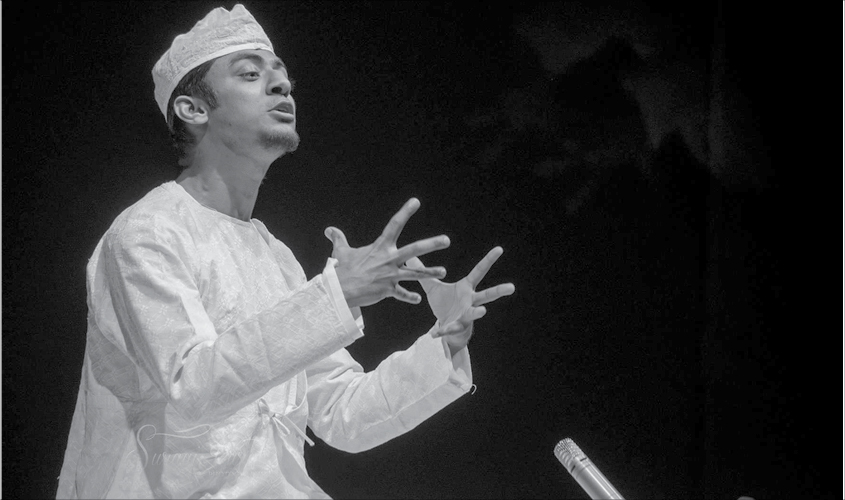I remember the last time I communicated with Ankit Chadha, whose sudden death by drowning on 9 May came as a shock to all those who had known the 30-year-old. He breathed new life into the art of storytelling, and is fondly remembered today for spreading the magic of Dastangoi, an Urdu oral storytelling form that dates from the 13th century, across the globe.
Ankit was a “Dastango” through and through. He was also known for his uniquely styled “musical dastan”, an interesting amalgamation of stories and music. When asked about how storytelling can make an impact on society, he said, “By listening to one another we can end violence, and this is the crux of storytelling…”
His own work in Dastangoi was heavily research-oriented, blending, in his own words, “informed ideas with the experiential knowledge to weave unique narratives”. “I personally engage with each story that I work on. It results in ownership over the text that I deliver orally. This way of life has made me look at the world as the most holistic educational tool,” Ankit told me a few months ago.
Telling stories was an important human endeavour for Ankit, as it has now become for countless others who are trying to take the art of storytelling to new heights.

Mehak Mirza Prabhu, an entrepreneur for over a decade, recently turned into a fulltime storyteller. He is the founder of Jhumritaliaya, a one-on-one online storytelling pathshala (classroom). “Being a storyteller”, Prabhu said, “has made me more compassionate and less self-absorbed, simply because I had to move out into the world to find these stories.”
Prabhu is passionate for the form, and his online classroom provides a multilingual forum for all those who care about stories. “Storytelling and telling a story are two different things. Classic storytelling, when combined with the original stories of today’s generation and the social issues, has the power to change the world mainly because they stir the mind and touch the soul by putting imagination to work. This art is celebrated and being revived with new techniques in many countries,” he added.
Kanupriya Aggarwal’s journey as a professional storyteller began when she wrote a five-second radio commercial. She is now the founder of “The Story Sparrows”, which she claims is Delhi’s first all-women storytellers’ group. The name itself is inspired by the little house sparrows flying from one spot to the other, and chirping cheerfully as though narrating some complex avian tale. “As a child, I was shy yet talkative, and, frankly, I cannot remember when I began with storytelling,” she said.
Aggarwal’s passion for storytelling was inspired by her great-grandmother, who would tell her countless stories, both fictional and non-fictional. “I believe in making every story my very own, and telling it the way in which we all would enjoy listening to it,” she said.
The challenges posed to contemporary storytellers, according to Aggarwal, have to do with the rapid commercialisation of this sector. Every storyteller now dreams of success and financial gains. But money adds nothing to this craft, which has to be nurtured with patience and time, and which gets better with our capacity for language.

Language, however, is only an optional resource for storytellers. Proving the same is Davai, a theatre group from Tel Aviv, Israel. Founded by three independent artistes, Fyodor Makarov, Losha Gavrielov and Vitaly Azarin, the group uses elements from circus and music to tell stories. The objective of their style is to heal society through humour and compassion, expressed by way of non-verbal storytelling and dramatics. Coming from a culture in which storytelling has been part of a 2,000-year-old tradition, it is no surprise that storytelling comes naturally to Davai, whose recent performances in India were a big hit.
But storytelling isn’t merely a performative art. It has a real therapeutic function as well. Fakat is a presenter at a community radio station, Alfaz-e-Mewat, in Haryana’s Nuh district, where he hosts a programme entitled Kuch Tum Kaho, Kuch Hum Kahen. The show aims to create mental health awareness among adolescents by presenting real-life stories of people who have been victims of gender-based discrimination, eve-teasing and bullying. The radio presenter firmly believes that a sensitive topic can be best communicated through the medium of the story. “Storytelling makes it [the instance] relatable while protecting the identity of the person concerned. After each episode, the number of positive feedbacks we receive is very encouraging. Establishing and maintaining connect with the audience is paramount, without which, the show can’t be successful. Arousing curiosity in the minds of the audience and taking them on a journey of a character they have never met is an art, and storytelling captures this beautifully, provided the nuances of this art—such as the links between the story and the interest and concerns of the audience; a well-modulated voice—are mastered,” said Fakat.
In the educational sector, storytelling is fast becoming an essential didactic tool. When Ananya Rana, a ninth-standard student, was asked about her experience with storytelling, she summed it up succinctly: “Storytelling is therapy for the senses, and helps both the narrator and the listener. This art hasn’t just made me a good speaker, but I also feel that I have become a good listener too.”
Nikita Seth, mother of a seven-year-old child, views the art of storytelling as an instrument to enhance the child-adult connect, and a means for the child to develop his or her creative imagination. She said. “Stories have a therapeutic effect on both children and adults, especially the ones narrated from personal experiences or biographies. This is a rich medium for imparting education as stories are comprehended better than instructions, and are more likely to be remembered and retold. They also impact behavioural change. Traits such as empathy are gradually nurtured, along with creativity and a rich imagination.”

